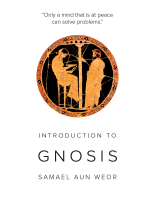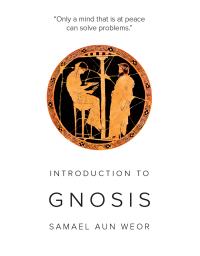Moses writes in Genesis:
“Let there be light: and there was light.” —Genesis 1:3
This is not something related with a remote past, no. This tremendous principle does not change through time. It is as eternal as eternity. It is a tremendous reality that exists from instant to instant, from moment to moment.
Let us remember Goethe, the great German initiate; his last words moments before his death were “Light, more light.”
Goethe is reincarnated in Holland. He has a physical body; though, now he does not have a masculine body, he has a feminine one and is married with a Dutch prince, and is now a Dutch lady of high society. This is very interesting, is it not?
Well, as I was saying, the light is very important. While one lives in the darkness, one will have to yearn for the light because one is blind. Light is the greatest desire of a person who is living in a cave, for one who lives underground amidst the darkness.
Indeed, the Essence1 is the most honorable and decent thing that we have inside. Its origin is the Milky Way, where it vibrates with the musical note La. When descending, it has to pass through the Sun with the musical note Sol. It enters this physical world (the physical body) with the note Mi.
The Essence is beautiful. It is, we would say, a fraction of the human-Christic principle that everyone has inside. It is the Human soul that normally resides in the Causal World. For this reason it is correct to say that the Essence is Christic, and that our consciousness in Christ will save us, etc.
All of that is true, but the problem with our consciousness is that it—being so precious, having so many marvelous virtues, precious natural powers—is trapped among all those undesirable subjective elements that unfortunately we carry within ourselves; that is to say, it is imprisoned in a dungeon. The Essence wants the light. How? By yearning for it! There is not one person who would not want the light, unless that person is already lost, but when one has some aspiration, one yearns for the light.
Therefore, one has to make light. To create light is something very serious, because it means the destruction of the receptacle or dungeon. This means to rescue, to liberate, to take the Essence out of the black den where it is imprisoned. Only then one will be as one should be: an illuminated person, an authentic clairvoyant, a real, luminous being that enjoys the plenitude that is our natural state, and that we have the total right to possess.
However, it happens that one needs heroism or a number of tremendous heroic acts in order to liberate the soul, to take it out of the dungeon, from the darkness where it is imprisoned.
It would be good if you could really comprehend in a conscious way what I am saying here, because it can happen that even while listening, you do not really listen, or that you will not feel the sense of the words that I am saying.
The light that shines in the darkness like a star of six rays in a nocturnal sky comes from our spermatic chaos.
It is beautiful to rescue the soul from the darkness, but it is not easy. The common situation for the Essence is to stay imprisoned. One will be unable to enjoy authentic illumination so long as the Essence, the consciousness, the soul, is trapped, imprisoned, and that is serious. Therefore, it is necessary, mandatory, to destroy the ego with a heroism superior to Napoleon and his great battles, superior to the fights of Morelos in his struggle for freedom, etc., in order to liberate the poor soul, to take it away from the darkness.
First of all, it is necessary to know the techniques, the procedures that lead to the destruction of those elements in which the soul is trapped, imprisoned, so that illumination can be attained.
Self-observation
The very beginning of this lies in understanding the necessity of knowing how to observe. We, for example, are all sitting in these chairs. We know that we are sitting, but we have not observed these chairs. In the first case, we have the knowledge that we are sitting in the chair, but to observe it, this is already something different.
In this case there is, I would say, knowledge but no observation. True observation requires a special observation: to observe what things are made of, and then to submerge oneself in meditation in order to discover their atoms, molecules; this requires directed attention. To know that one is sitting in a chair is non-directed attention, passive attention, but to observe the chair is directed attention.
In the same way, we can think a lot about ourselves, but this does not mean that we are observing our own thoughts; to observe them is different.
We live in a world of inferior emotions. Anything can generate an inferior emotion in us. We can know that we have them, but it is one thing to know and another to observe the negative state in which one is; that is something completely different.
Let us see an example. On a certain occasion, a gentleman said to a psychologist, “Well, I feel antipathy for a certain person” (he said the name).
The psychologist answered, “You have to observe. Observe that person.”
The gentleman asked, “But what do I have to observe him for, if I already know him?”
The psychologist arrived at the conclusion that this person did not want to observe; he “knew,” but was not observing.
To know is one thing, and to observe is something absolutely different. One can know that one has a negative thought, but it does not mean that one is observing it. One knows that one is in a negative state, but that is not the same as observing the negative state.
In practical life, we see that within ourselves there are many things that give us reason to feel ashamed: ridiculous comedies, grotesque inner things, morbid thoughts, etc. To know that one has these things is not the same as to have observed them.
Somebody could say, “Yes, in this moment I have a morbid thought.” It is one thing to know that one has a morbid thought, and another to observe the thought.
If one wants to eliminate a particular undesirable psychological element, first of all one has to learn to observe with the intention of attaining a transformation, because certainly, if one does not learn to self-observe, any possibility of transformation is rendered impossible.
When one learns to self-observe, one develops the sense of self-observation. Commonly, this sense is atrophied in the human race; it is degenerated. But in accordance with its use, it develops and unfolds.
Firstly, through self-observation we can verify that the most ridiculous comedies and even the most insignificant thoughts that appear internally and that are never externalized are created by others, by the “I’s.” It is a serious thing for one to become identified with those comedies, with that ridiculousness, with those protests, with that anger, etc. If one is identified with any of those inner extremes, the “I” that produced them becomes stronger and in this way any possibility of elimination becomes more and more difficult. So, observation is vital when we want to produce a radical transformation within ourselves.
Through the Hermetic Work,2 we crystallize what before was diffused in the sinister and vulgar mass of the “I’s.”
The different “I’s” that live within our psyche are very astute, very smart. Many times they use the memories that we carry in the intellectual center. Let us suppose that in the past we fornicated with a person of the opposite sex and that now, we are trying (or not trying) to eliminate the lust. The “I” of lust will use the center of memories, the intellectual center, take the memories that it needs and make them into a fantasy of the person, so the “I” will become stronger. Each time it will become stronger.
For all of this, you have to see the necessity of self-observing. Radical and definitive change is not possible if we do not learn to observe ourselves.
To know does not mean to observe. To think does not mean to observe, either. Many people believe that to “think” in oneself is to observe, but it is not. One can be thinking in oneself, however this is not observing. To think in oneself and self-observation are as different as a net and water or water and thirst.
Obviously, one must not be identified with any of the “I’s.” In order to perform self-observation, one has to divide oneself in two, in two halves; one part that observes and the other that is observed. When the part that observes sees the ridiculousness and stupidities of the observed part, there are great possibilities to discover (suppose the “I” of anger) that this “I,” is not us, that he is he. We could exclaim then, “The ‘I’ of anger is an ‘I,’ it has to die; I will work on it in order to disintegrate it!”
But if one is identified with the defect and says, “I have anger, I am furious!” then the defect becomes stronger, and in this condition, how could we eliminate it? Well, it would not be possible. Therefore, one must not be identified with that “I,” with its rage or with its tragedy, because if one is identified with one’s own creation (the “I”), one ends up living his own creation, and that is something absurd.
According to one’s work on oneself, as one advances deeper in the field of self-observation, one’s observation becomes more and more profound. In this work, one should not overlook even the most insignificant thought; any desire, even if it is transitory, any reaction, has to be a cause for observation, because any desire, any reaction, any negative thought, comes from a particular “I.” If we want to make light, to liberate the soul, will we allow the existence of those “I’s”? That would be absurd!
If light is what we want, if we are really in love with the light, then we have to disintegrate the “I’s.” There is no other solution but to reduce to dust what we have observed in ourselves; therefore, we need to know how to observe ourselves.
Chatter
In this field, we have to be careful with inner chatter, because there are many negative and absurd inner dialogues; there are many inner talks that never end. Naturally, we need to correct that situation. To learn to be silent, to know to speak when it is necessary to speak, to know to keep silent when it is necessary to be quiet (this is the law not only for the physical world, the external world, but also for the inner worlds).
Negative inner chatter, when exteriorized physically, is harmful. This is the reason why it is so important to eliminate that negative aspect; it is necessary to learn to keep internal silence.
Normally, mental silence is defined as emptying the mind of any class of thoughts, as when one achieves the quietude and silence of the mind through meditation, etc. However, there is another type of silence. Let us suppose that there is presented to us a case of critical judgement, a case that is related to someone else, and we keep a mental silence; we do not judge, we do not condemn, we remain silent externally and internally; in this case, there is inner silence.
The facts of practical (external) life are in intimate relation with perfect inner behavior. When the facts of practical life are in harmony with perfect inner behavior, it is a clear signal that we are creating within ourselves the famous mental body.
Inside of each one of those different quarrelsome and bawling “I’s” that personify our psychological errors is a substance: the psychic Essence. Just as the splitting of an atom liberates energy, so too does the total disintegration of the different infernal “I’s” liberate the Essence, the light. So, we have to make light.
If we put the different parts of a radio or tape recorder on a table but do not know anything about electronics, we would not be able to receive the different soundless vibrations that fill the cosmos. But if through comprehension we connect the different parts, we will have a radio; we will have the instrument that can perceive sounds that we would not otherwise perceive. In the same manner, the different parts of these studies, of this work, complement each other in order to form a marvellous body: the famous body of the mind. This body will let us perceive in a better form all that is within us and will develop even further the sense of inner self-observation. That is very important!
So, the object of observation is to produce a change within us, to promote an authentic and effective change.
Once we have become skillful in the observation of ourselves, then comes the process of elimination.
There are three steps or stages in this matter: first, the observation; second, the critical judgement, and the third is the elimination of a particular psychic “I.”
“I’s” in the Five Centers
Once we are observing an “I,” first we have to see its behavior in the intellectual center to know all its games in the mind; second, how it expresses itself through feelings in the heart; and third, to discover its way of action in the inferior centers: motor, instinctual, and sexual.
Obviously, an “I” expresses in one way through the sexual center, in another way through the heart, and in yet another way through the brain.
In the brain, an “I” expresses itself through the intellect: reasons, justifications, subterfuges, evasions, etc.
In the heart, it may express as a suffering, as an affection, and many times as an apparent love, even when it is just lust, etc.
In the motor-instinctual-sexual centers, it will have another form of expression: as action, as an instinct, as a lascivious impulse, etc.
For example, let us take a concrete case: lewdness or lasciviousness. A lustful “I” facing a person of the opposite sex can express itself in the mind as constant thoughts. It could appear in the heart as an apparently pure love, without any stain, such that one could justify oneself and say, “Well, I do not feel lewdness for this person, what I am feeling is love.” But if one is sensitive, if one pays attention to the human machine and observes the sexual center, one discovers that in the sexual center there is some activity in relation to that person. Then we verify that it is not affection, that there is no real love, but only lust.
But let us observe how slender is the crime: lust can be perfectly concealed in the heart as love, leading us to write poems, etc., but indeed, it is concealed lust. If one is careful and observes the five centers of the machine, then one can verify that it is an “I.”
When we have already discovered that it is an “I,” when we have known its behavior in the five centers, in the intellect, in the heart, and in the motor-instinct-sex, then one can pass to the third stage. What is the third stage? The elimination; that is the final stage of the work. One then has to use prayer in the work. What do we understand about prayer in the work? Prayer in the work has to be practiced having as its foundation, Inner Self-remembrance.
On certain occasions we said that there are four levels of people, or four states of consciousness.
The first state of consciousness is the profound and unconscious dream of a person, of an ego that left the body sleeping on the bed, but that walks in the Molecular World in a comatose state; that is his inner state.
The second state of consciousness is the one of the dreamer who has returned to the physical body and believes that he or she is in a “waking state.” In this case the dreams remain, for sure, but the person is with the physical body in a waking state. This second type of dreamer is more dangerous because he can kill, he can steal, he can commit crimes of any kind.
In the first case, the dreamer is more infra-human, but cannot do any of those things. How could he? How could he damage somebody? When the body is passive to the dreams, the person cannot damage anybody in the physical world. However, when the body is acting out the dreams, that person can create a lot of damage in the physical world. So that is why the sacred Bible emphasizes the necessity of awakening.
These two types of persons are in a state of profound unconsciousness. If they pray while within those two types of infra-human states, nothing good can be expected. However, nature will answer. For example, an unconscious person, a dreamer, goes to pray in order to get a deal, but it can happen that among those many “I’s,” some do not agree with what the dreamer is asking for, because the prayer is for just one of those “I’s”; the other “I’s” were not taken into consideration. Therefore, it could happen that the other “I’s” do not feel any interest in that deal and do not agree with that prayer, and pray exactly the opposite in order to make that deal fail. Because they disagree, because the other “I’s” are the majority, nature answers with its forces, with a flow of forces, and the deal fails; that is clear!
Thus, in order to get an effective result with prayer in the work on ourselves, one has to use the third state of consciousness, the Inner Self-remembering of our own Being.
Submerged in a profound meditation, concentrated in the inner Divine Mother, one will supplicate her to eliminate from the psyche the “I” that one wants to disintegrate. It could happen that the Divine Mother in that moment might act beheading that “I,” but this does not mean that the totality of the work has been done. The Divine Mother will not disintegrate everything instantaneously. It will be necessary to be patient. In successive works, through time, we will get the slow disintegration of that “I”; it will lose size and volume.
An “I” can be frightfully horrible, but in accordance with its lost volume it becomes more beautiful; then it takes the aspect of a child and finally becomes dust. When it is reduced to dust, the consciousness that was trapped, imprisoned, inside of that “I” is liberated, and the percentage of light within ourselves is increased. It will be a percentage of light that is free. In this manner we will proceed with each one of those “I’s.”
The work is long and very hard. Many times a negative thought, even an insignificant one, is originated by an ancient “I.” The negative thought that comes to the mind indicates that there is an “I” inside of the thought, and that “I” has to be extirpated, eradicated from our psyche.
It is necessary to study and know its conduct, to see how it behaves in the five centers: in the intellectual, in the emotional, and speaking in synthesis, in the motor-instinctual-sexual; to see how it works in each one of these three brains. According to how the “I” behaves, one gets to know the defect.
When one has developed the sense of self-observation, one can verify that some of those “I’s” are frightfully horrible, real monsters of horrifying and macabre forms that live within our psyche.







